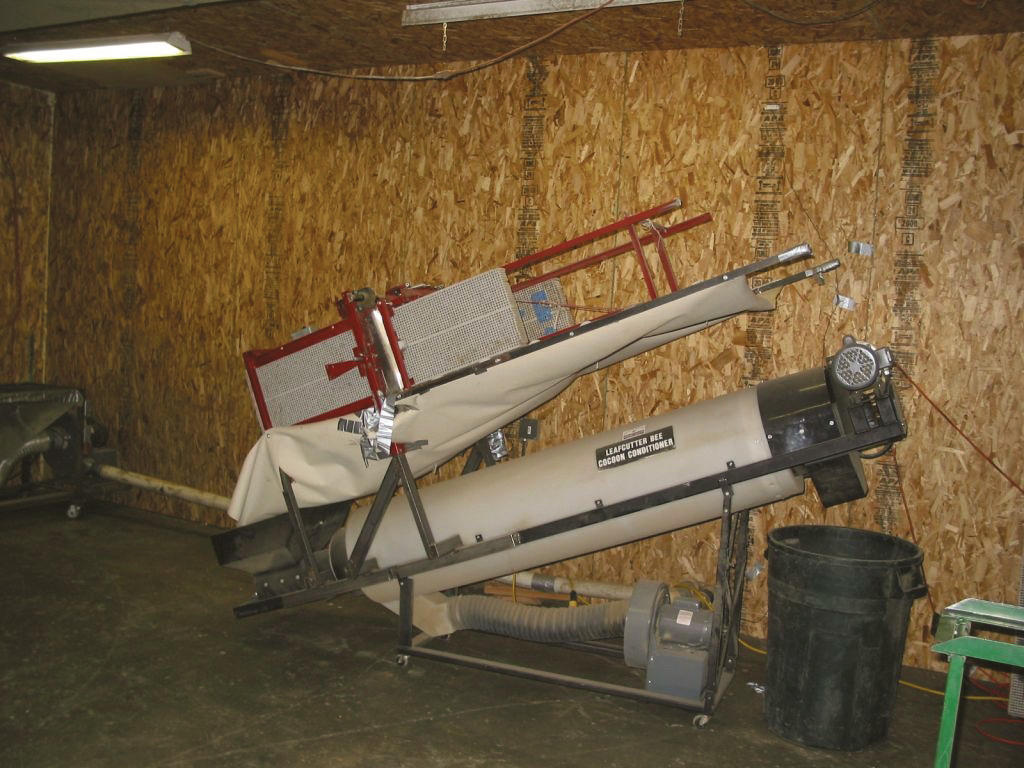
Processing loose cells requires several pieces of specialized equipment. “Cell strippers” are machines used to punch cells from nest blocks, and tumblers break apart the individual cells and remove parasites and debris (Figure 7.19). Dip tanks are used to hold strong bleach solutions for disinfecting nests. The scale and level of sophistication varies between producers from small, hand-operated devices, to large automated systems that can process hundreds of thousands of cells per hour. Unfortunately, due to the small number of leafcutter beekeepers, there are few commercial suppliers of processing equipment, the equipment is not cheap, and often machines will only function with one type of nest. As a result much of this equipment is homemade or custom fabricated.
Solid-block cell strippers remove cells from nest blocks using a series of plunger rods that are depressed into the nest tunnels. As the cells are ejected out the back of the nest block they fall through a chute into a collection bin. Manually operated solid-block strippers often have a hydraulic lever which, when pulled down, automatically lifts the plunger rods while the operator repositions the next block.
Grooved-board nest strippers separate the individual nest boards and feed them through a series of blunt teeth. As the teeth scrape across the board, cells fall into a collection bin, and the boards slide into a chute where they are restacked. Manual grooved-board strippers require the operator to carefully pry each board apart and push it past the teeth.
Cell tumblers are used to remove dust, excess leaf pieces, parasites, and debris, as well as to break up individual cells for easier storage. A typical tumbler will consist of a screened drum with a 3/16-inch mesh (4.8 millimeters). The drum is hand cranked or rotated by an electric motor, allowing the debris to fall through the screen. Sophisticated tumblers will incorporate blowers to remove dust, and will feed the processed cells directly into storage containers or incubation trays. Because of the large amounts of dust produced, cells should be tumbled outdoors, or with proper respiratory protection (see sidebar).
Care should be taken to prevent over-tumbling the cells resulting in the removal of too much leaf material and the exposure of prepupae. When tumbling, maintain a low speed so that cells do not ride up past the sides of the tumbler.
After cell removal, nests should be disinfected in a dip tank containing a bleach and water solution (1:3 by volume) for five minutes. Automated “paddlewheel” type dip tanks are available that can disinfect a series of nest blocks at one time. Wood nest blocks can also be heat sterilized with steam or in small lumber kilns, although success can be limited.
In addition to disinfecting nests, some beekeepers decontaminate the cells themselves by submerging them in a bleach and water solution (1:3 by volume) for one minute. There is some debate among researchers and producers as to the merit of this practice, and there is a significant potential for harming the larvae if mistakes are made. Based on current information, this practice is probably only of value as a last resort in bee populations with high levels of chalkbrood.
For beekeepers who do not want to process their own loose cells, several bee brokers provide custom stripping and nest cleaning services.
